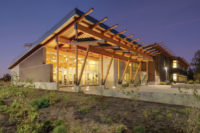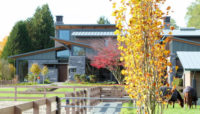Architects can help create healthy communities. When people think of health, often the first thing that comes to mind is the medical industry, doctors, nurses and those who make us healthy when we are unwell. Let’s turn that model on its head and instead examine a very important preventive strategy to help people from becoming sick — designing healthy communities. Architects are a key part of a wellness strategy that focuses less on intervention when people are sick and more on how to keep people healthy and out of doctors’ offices and hospitals in the first place.
Design is preventive medicine. The architects’ role is not only to design exceptional healthcare facilities, but to also design communities that promote wellness. We as a nation have been spending billions of dollars on drugs and other medical innovations to cure those that have become ill. With healthcare costs in the U.S. projected to grow toward nearly 20 percent of GDP by 2020, can we really afford to continue down this current path?
What if we diverted even some of this money to keeping patients well, so that when they do require a doctor or a stay in a hospital, they are in shape to make a speedy recovery? The prescription for such a transformation is not a new pill or fad diet. It’s health by “design.” It’s about the way we shape our communities to encourage walking, clean air, open spaces for relaxation and recreation, and access for those physically challenged. It’s about the role architects can play and are playing in the shaping of more livable, sustainable and healthy communities.
Place is reflective of health. Studies have shown that people living in urban areas are in better shape than individuals living in suburban and exurban communities. When you think of why this is, it is actually rather intuitive — city dwellers often walk, bike or take transit to work; they walk to nearby services like grocery stores and dry cleaners, and for other day-to-day necessities; and they live in smaller homes and therefore take more advantage of community amenities like parks and trails.
“Twelve studies compared the behavior of residents in automobile-oriented (or suburban) communities with those in traditional (or urban) communities. Overall, the median improvement in some aspect of physical activity (e.g., number of walkers or bicyclists) was 161 percent.”1
“Six studies assessed the relationship between the perceived environment and physical activity practices, or effectiveness in providing a more inviting and safer outdoor environment for activity. Overall, the median improvement in some aspect of physical activity (e.g., number of walkers or percent of active individuals) was 35 percent.”2
Healthy living is sustainable. Architects have been at the forefront of designing sustainable buildings. The public, however, generally views green buildings as purely focused on reducing energy and water use, which is incredibly important. Energy savings do lead to reduced air pollution, which is linked to four major health threats: increased mortality, respiratory illness, impaired cardiovascular functions and increased cancer risk. Children are especially vulnerable to these risks.
A very important aspect of green building is also to explicitly design healthy buildings that provide superior indoor air quality, increased access to natural daylight, improved acoustics, and create all around healthier and more inviting spaces. Green schools are part and parcel of this plan, by helping to prepare the next generation for healthier, more sustainable living — and shape adult behavior as a result — while providing America’s youth with healthy spaces to learn.
We found in our most recent report, co-published with the USGBC, Local Leaders in Sustainability: Special Report from Sundance:
As a rough estimate, a green school could lead to the following annual emission reductions per school: 1,200 pounds of nitrogen oxides (NOx) — a principal component of smog; 1,300 pounds of sulfur dioxide (SO2) — a principal cause of acid rain; 150 pounds of course particulate matter (PM10) — a principal cause of respiratory illness and an important contributor to smog. Buildings become part of a smart strategy to increase productivity, reduce sickness, and create well-prepared young minds.
Hood River Middle School in Portland, Ore., is a perfect example of this smart strategy. The school’s renovation included the addition of a new free-standing, net-zero LEED Platinum-certified science lab. Renovations came with a 58 percent reduction in total energy use, which equates to removing 162 cars from the road. The project also achieved a 98 percent reduction in potable water use; pumping and treating water also uses energy and creates toxic emissions (These two paragraphs are excerpted from the report, with the middle school project profile on page 8).
Public policy is a solution. Innovative policies are being pursued by cities nationwide that are making a difference. We have seen this here in the Washington, D.C. region with pioneering planning measures, transit-oriented development, and multimodal options ranging from walking to bike-sharing to the metro.
Arlington, Va., has focused dense urban development near Metro stations, bolstering health in the community by creating walkable urban villages. County programs, including FreshAIRE, WalkArlington and the Car Free Diet — with high levels of civic engagement — work together with long-range smart-growth planning, the Arlington green building program, and the new Community Energy Plan, to create a healthy, livable community.
WalkArlington recently released the 2011 Arlington County Community Services survey, which interviewed 985 respondents and demonstrated that half of those surveyed walk daily throughout the county. Fifty-six percent of residents walk for at least part of their commute at a minimum of once a week and 86 percent make a trip, at least twice a week, completely by walking — the top reasons given for walking is getting exercise or running errands.
All of these measures seek to offer choices for residents to live, work and play by utilizing options beyond just the automobile. Many cities throughout the country have been headed in a direction. This is because focusing development near city centers and transit not only provides a healthier environment for residents, but it also uses existing urban infrastructure and reacts to market demand for increased housing choices. Standout examples can be seen in cities across the country, including Chicago, Denver, Portland, San Francisco and Somerville, Mass., among others.
New York City’s innovative plan is especially worthy of highlighting, as the city is working in imaginative ways to get the public moving. In a city where personal automobile usage is the lowest in the country, it is still possible to do more and take it to the next level. The Active Design Guidelines, released in 2010, seek to make a big difference often in small ways. These guidelines, created with help from the American Institute of Architects New York City Chapter, focus on design features like stairwells, indoor and outdoor spaces, walking routes and pedestrian-friendly features, and make an outsized difference on how individuals interact with the built environment and make healthier decisions.
The new Cooper Union Building by Morphosis is a great project to highlight. See http://americancity.org/buzz/entry/1996/ for more information.
A stronger focus on wellness is taking hold in society. With this focus and the knowledge that the power of design can make places that are sustainable, walkable, livable and healthy, there is a clear opportunity for action. A diverse constituency of engaged community members that share a common goal of crafting healthier communities does make a difference. Collaboration is the cornerstone of this type of vision-making. By bringing together architects, others in the design and construction community, government officials, healthcare professionals and, most importantly, members of the public, we can design healthier communities.
1 Centers for Disease Control and Prevention, Community Preventive Services Task Force, available at http://www.thecommunityguide.org/pa/environmental-policy/communitypolicies.html.
2 Ibid






